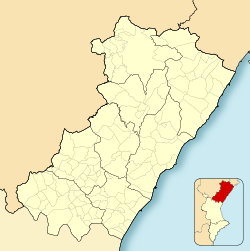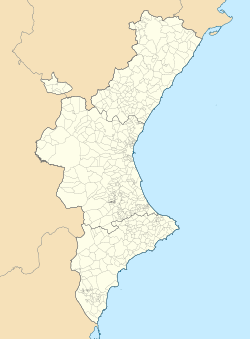La Vall d'Uixó facts for kids
Quick facts for kids
La Vall d'Uixó
|
|||
|---|---|---|---|
 |
|||
|
|||
| Country | |||
| Autonomous Community | |||
| Province | Castellón | ||
| Comarca | Plana Baixa | ||
| Judicial district | Nules | ||
| Budget | €30,724,344.68 (2009) | ||
| Linguistic area | Valencian | ||
| Founded | 1250 | ||
| Temperatures | Highest 42 °C / Lowest 3 °C | ||
| Precipitation mm | 509.51 mm. year | ||
| Government | |||
| • Type | Ajuntament | ||
| Area | |||
| • Total | 67.10 km2 (25.91 sq mi) | ||
| Elevation | 118 m (387 ft) | ||
| Population
(2018)
|
|||
| • Total | 31,552 | ||
| • Density | 470.22/km2 (1,217.87/sq mi) | ||
| Men: 16813 Women: 16858 Spaniards: 32976 Foreigns: 695 | |||
| Demonym(s) | Vallero/a (Spanish) and valler/a (Valencian) | ||
| Time zone | CET (GMT +1) | ||
| • Summer (DST) | CEST (GMT +2) | ||
| Postcode |
12600
|
||
| Website | Ajuntament de la Vall d'Uixó | ||
La Vall d'Uixó (also known as La Vall) is a town in eastern Spain. It is located in the Valencian Community, within the province of Castelló. La Vall is about 25 km south of Castelló, the province's capital. It's also 45 km north of Valencia, the community's capital. The town is only 8 km from the Mediterranean Sea and sits 118 m above sea level.
Contents
History of La Vall d'Uixó
The area where La Vall d'Uixó is today has been home to people for a very long time. Early humans lived here in prehistoric times.
Ancient Times: Caves and Early Settlements
The Cova de Sant Josep (Saint Joseph's Cave) and other nearby caves show the oldest signs of human life. Archaeologists found that hunters lived in these caves around 16,000 BC. They even found ancient cave paintings, which tells us how important this place was.
People continued to live in the valley during the Neolithic and Bronze Age. During the Bronze Age, villages grew on top of mountains. These villages had strong walls and watchtowers. Their high location helped them control a large area and guard the path into the Serra d'Espadà mountains.
Iberian and Roman Periods
During the Iberian era, the population grew a lot. Evidence of this comes from the ancient Iberian city of La Punta d’Orleyl and the Poblat Sant Josep. La Punta d’Orleyl was a large city with four layers of walls and towers. Its main area, called the acropolis, had remains of big public buildings made from huge squared stones.
The Poblat de Sant Josep, located on a hill, is a good example of ancient city planning. It was small but had a wall, two towers, streets, and houses from both the Iberian and Roman times. It was most important during the Iberian period. It was also used in the 4th century AD, towards the end of the Roman Empire.
During Roman times, people in the area focused more on farming. A few years ago, archaeologists found a necropolis (an ancient burial ground) from the 6th and 7th centuries. This was during the Visigothic period. They found the remains of 66 people along with items buried with them.
Muslim Influence and Christian Rule
The Arab conquest and their settlements didn't change daily life much. Over a long period, about a dozen villages existed along the Belcaire river. These included Alcúdia, Zeneja, Benigafull, Benizahat, Zeneta, and Benigasló. Each village was independent and had its own workshops and burial sites.
The main political center for La Vall was the Castell d'Uixó (Uixó Castle). In 1250, La Vall received its Carta Pobla, which was like a special charter. From then on, La Vall became an important city in the Kingdom of Valencia. Even with this change, the Muslim community in La Vall kept their way of life.
However, things changed a lot after the expulsion of the Moors in 1609. While the plan was to replace all Muslim citizens with Christians, many Moors stayed. They kept their homes and continued working the land and their crafts, but under Christian control.
Modern Growth and Economy
In the 18th century, La Vall's population grew significantly. The six smaller villages joined together to form two larger areas: El poble de Dalt (Upper Town) and El poble de Baix (Lower Town). By the 19th century (around 1860), these two towns formed a central square where the City Hall is located today.
The 20th century brought another big period of growth for La Vall. Many people moved here because of the growing shoe industry. This industry was very important until the early 1990s. After a time of economic difficulty when the shoe factories closed, La Vall changed its focus. Now, its economy is mainly centered on city commerce and tourism.
- For more information: La Vall d'Uixó City Council
Geography of La Vall d'Uixó
La Vall d’Uixó is located in the valley of the Belcaire river, close to the Mediterranean Sea. This great location gives it a typical Mediterranean climate. It's 25 km south of Castelló and 45 km north of Valencia. Being 8 km from the sea and 118 m above sea level makes it a pleasant place to live.
La Vall is one of the most successful cities in the province of Castellón due to its strong economic and social growth in recent decades.
It is surrounded by several other towns in the Plana Baixa area, including Almenara, Alfondeguilla, La Llosa, Moncofa, Nules, and Xilxes. It also borders Sagunto in Valencia's province.
As the La Vall Anthem mentions, the town is surrounded by many mountains:
- Penya Migdia (550 m)
- Penya-Creuc (326m)
- Ródeno (538 m)
- Pinyal (309 m)
- Font de Cabres (637 m)
- La Pitera (645 m)
- Penyalba (648 m)
- Pipa (591 m)
- El Frontó (621 m)
- Sants de la Pedra (585 m)
- El Castell (492 m)
- Sumet (450 m)
- La Balona (456 m)
- Penya Garrut (412 m)
- Alto de Cerverola (492 m)
Flora: Plants of La Vall
The soil in La Vall is rich and varied. The area is known for producing a lot of citrus fruits. You can also find carob trees, olive trees, pine trees, and white mulberry trees throughout the town's district.
Belcaire River
Locals often call the Belcaire river the "Barranco de San José." It has several smaller rivers that flow into it, such as "La rambla de Cerverola," "Barranc de Randero," and "Barranc de l'Alcúdia." These smaller riverbeds are usually dry for most of the year. The Belcaire river starts in the Alfondeguilla mountains and flows into the Mediterranean Sea near Moncofa.
Population of La Vall d'Uixó
La Vall d’Uixó covers an area of 67.10 km2. According to the 2009 census, it had a population of 33,670 people. This makes it the fourth largest city in the province of Castellón by population. The cities with more people are Castelló de la Plana, Vila-real, and Borriana.
The population in 2009 included 16,813 men and 16,858 women. Most residents were Spaniards (32,976), with 695 foreigners.
| Population Changes in La Vall d'Uixó (1857-2007) | |||||||||||||||||||
|---|---|---|---|---|---|---|---|---|---|---|---|---|---|---|---|---|---|---|---|
| 1857 | 1887 | 1900 | 1910 | 1920 | 1930 | 1940 | 1950 | 1960 | 1970 | 1981 | 1991 | 1996 | 2002 | 2006 | 2007 | ||||
| 7,229 | 8,506 | 8,643 | 8,856 | 8,807 | 9,216 | 9,630 | 11,712 | 18,596 | 24,105 | 26,145 | 27,387 | 28,283 | 29,871 | 31,553 | 31,978 | ||||
Culture and Traditions
As part of the Valencian Community, La Vall d'Uixó celebrates common local festivals.
Festivals
- Falles: A traditional festival with large artistic sculptures that are later burned.
- Les Penyes en Festes: These celebrations have been held in the first week of August since 1982.
Language
La Vall d'Uixó is in the area where Valencian is spoken. Valencian is the local language of the Valencian Community.
Economy and Tourism
La Vall d'Uixó's economy has changed a lot, especially since the middle of the last century.
Economic Development
The town's economic growth was based on a few key areas:
- Industrialization: The growth of factories and manufacturing.
- Agriculture: Changing from rain-fed farming to irrigated farming, focusing on citrus fruits.
- Tourism: Developing attractions like the "Les Coves de Sant Josep."
- Population growth: Many people moved to La Vall for work.
Today, the construction sector is a major employer, followed by the footwear and leather industries. La Vall d'Uixó also uses its rich history and natural beauty to attract tourists. Its closeness to the Espadán natural park and the Mediterranean coast helps with this.
Popular Tourist Spots
La Vall d'Uixó has interesting historical sites.
- Les coves de sant Josep (Saint Joseph's Caves): This is a very important site. It has ancient cave paintings and is home to the longest navigable underground river in Europe. You can take a boat ride inside!
La Vall has two historic town centers. This is because it was formed by joining "El poble de Baix" (Lower Town) and "El poble de Dalt" (Upper Town). The Assumpció Church is in the Lower Town, and the Àngel Church is in the Upper Town. Both centers still have their original historical layout.
Monuments to Explore
La Vall d'Uixó has many beautiful and historic buildings.
Religious Monuments
- Ermita del Santíssim Crist del Calvari (18th century): This hermitage is in the Carbonaire neighborhood. It has old glazed tiles on its front.
- Església del Santíssim Crist del Calvari: A church dedicated to the Holy Christ of Calvary.
- Església de Ntra. Sra. de l'Assumpció: This church has a beautiful Baroque-style front. It was built in the late 17th century. The Capilla del Sagrari (chapel) is special, with old glazed tiles. It also has an organ that was rebuilt after being destroyed in the civil war.
- Ermita de Sant Vicent Ferrer (17th century): Located in Sant Vicent Square. It might have been built on the site of an old Muslim mosque.
- Ermita de La Sagrada Família (18th century): Found in the San José area. Next to it, there was another hermitage, which is now an Information Center.
- Ermita de sant Antoni (late 17th century): This hermitage is in the San Antonio's Group neighborhood. Once a year, people make a pilgrimage here for the saint's feast day.
- Ermita del Roser: In the El Roser neighborhood. It is one of the oldest churches in La Vall.
- Església del sant Àngel: The main church of El Poble de Dalt (Upper Town).
Civil Monuments
- Torre de Benizahat: Located on Nostra Senyora de l’Assumpció street. This tower was built in the 12th century by Muslim people.
- Hispan-Visigothic necropolis: Found in La Unió neighborhood. This ancient burial ground was recently excavated. Eight graves were found with the remains of 66 people from the 6th and 7th centuries AD.
- Iberian city of Punta Orley: These are the remains of an ancient city whose original name is unknown. Parts of it have been excavated. You can see remains of two large stone public buildings and four layers of walls from different time periods.
- Acueductes de sant Josep i l'Alcúdia: Located in the El Roser neighborhood. After the Saint Joseph's Caves, these aqueducts are the most important attractions in the town. The Romans built the aqueduct, and it was repaired several times during the Middle Ages.
Weather in La Vall d'Uixó
During summer, temperatures can reach up to 42 °C. In winter, the lowest temperatures drop to around 3 °C. The town receives about 509.51 mm of rain per year.
Local Food: Gastronomy
The food in La Vall d'Uixó is influenced by traditional Valencian cuisine. Paella is a very popular dish, often cooked for Sunday lunch. While there are not many dishes unique to La Vall, some local favorites include:
- Coca en tomata i barrets: A typical cold dish for celebrations. It's a special pastry with tomatoes and vegetables.
- Empedrao: An old hunter's meal made with pork, rice, beans, shredded beef, rabbit or hare, and partridge.
- Manjóvenes: A very light Muslim pastry.
- Panets: Made with figs and almonds, pressed into a special mold.
- Arròs al forn: A very traditional baked rice dish with ribs, sausages, chickpeas, and tomatoes. Some people add other ingredients too.
Sports in La Vall d'Uixó
La Vall d'Uixó has three football (soccer) teams: Unión Deportiva Vall de Uxó, Club La Vall, and Castell d'Uixó. All of them play in regional leagues. The town also has a Tennis Club.
Notable People from La Vall d'Uixó
- Josep Peirats: An anarchist writer.
- Alex Debón: A professional motorcycle racer (250cc).
- Tony Ferrer: A musician.
- José Mangriñán: A football player.
- Arturo Tizón: A professional motorcycle rider.
- Francisco: A singer.
- José Font Borrás: He founded La Vall's Football Team.
- Jose Vicente Arzó: Won a silver medal in the Paralympic Games in 2008.
- Sara Sorribes Tormo: A tennis player.
Twin Cities
La Vall d'Uixó has special connections with these cities:
 France, Valence d'Agen
France, Valence d'Agen Mexico, Juchitán de Zaragoza
Mexico, Juchitán de Zaragoza Western Sahara, Hagunia
Western Sahara, Hagunia
See also
 In Spanish: Vall de Uxó para niños
In Spanish: Vall de Uxó para niños







